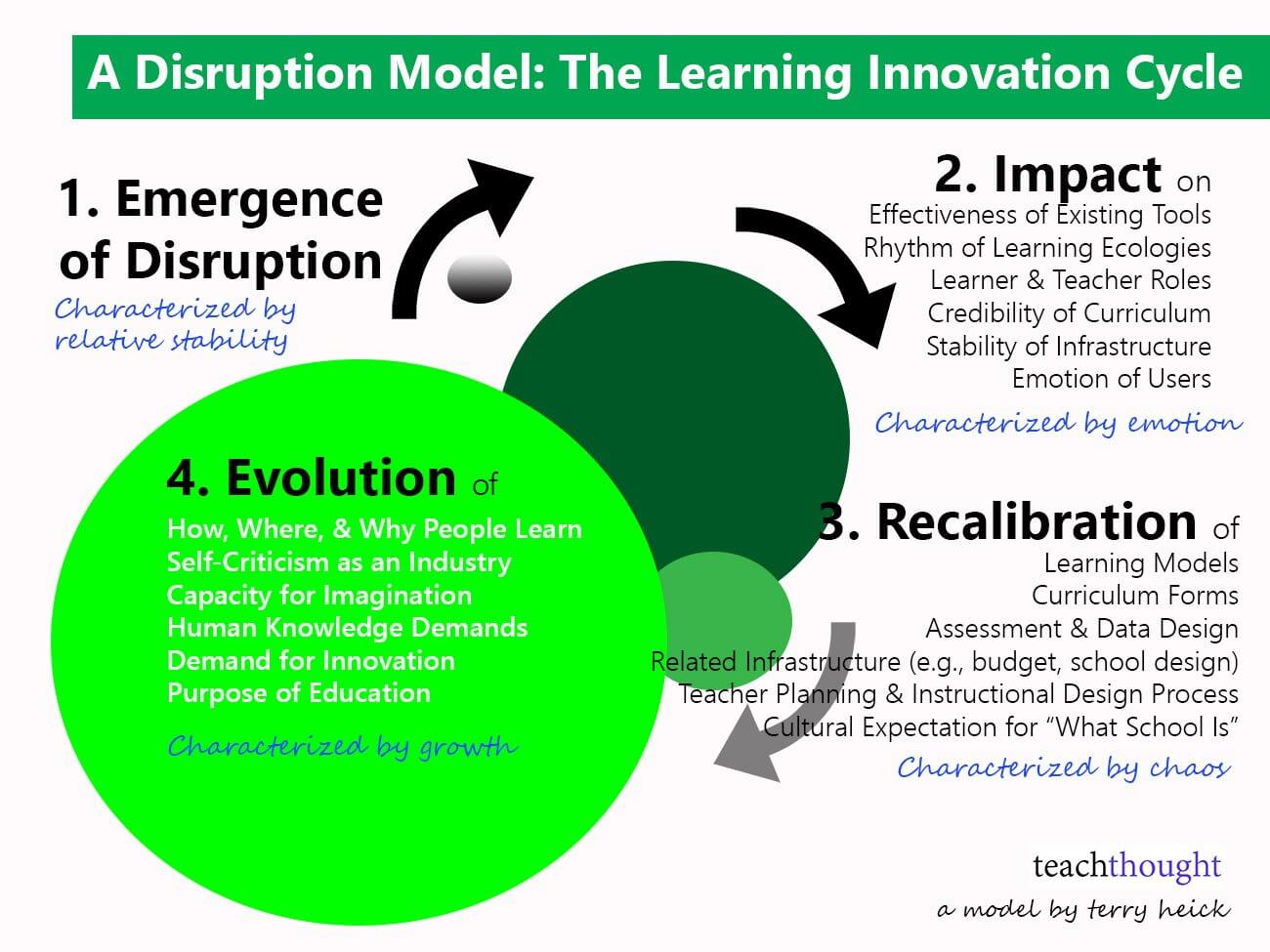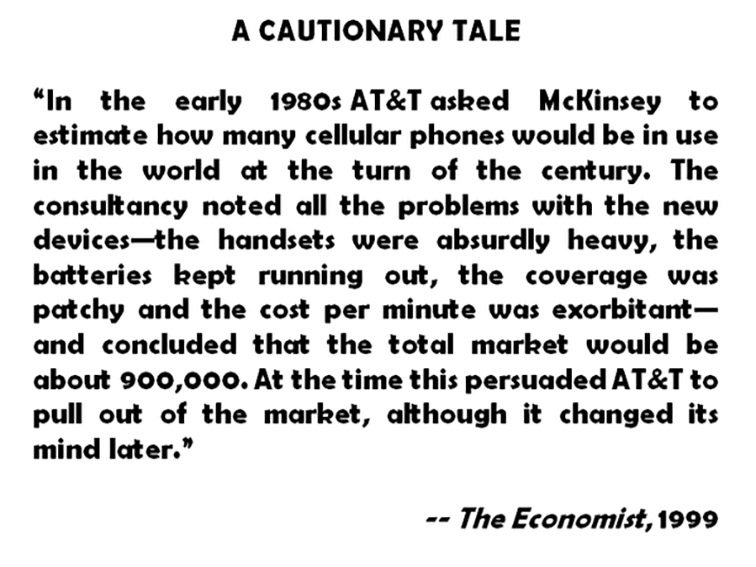
Disruptive Innovation In Education Can Create Lasting Change
Disruptive innovation in education is an interesting topic for the same reason that cowboys, gangsters, and villains are interesting: It’s unpredictable, challenges the status quo, can be problematic and almost always, by definition, goes against the grain.
It’s kind of aging as a buzzword in the ‘education space,’ but it’s other-worldly powerful, and there are few things education needs more. How exactly it produces change is less clear, but I thought I’d create a model to think about.
First, a quick preface. The iconic vision of disruptive innovation of education comes from Clayton Christensen, who uses the term to “describe a process by which a product or service takes root initially in simple applications at the bottom of a market and then relentlessly moves up market, eventually displacing established competitors.”
“Companies pursue these “sustaining innovations” at the higher tiers of their markets because this is what has historically helped them succeed: by charging the highest prices to their most demanding and sophisticated customers at the top of the market, companies will achieve the greatest profitability. However, by doing so, companies unwittingly open the door to “disruptive innovations” at the bottom of the market. A disruptive innovation allows a whole new population of consumers at the bottom of a market access to a product or service that was historically only accessible to consumers with a lot of money or a lot of skill.”
I usually think of disruptive innovation as any change that forces itself substantially on existing power sets. This force causes transfer–a redistribution of something–market share, money, credibility, knowledge, or something we collectively value. Here, in this literal re-vision (seeing again) and neo-vision (seeing new), is where enduring learning innovation can be born.
In education, most of the talk around disruptive innovation revolves around education technology, owing to the potential scale of these technologies, and desperation of education to revise itself. But innovation doesn’t necessarily have to be a matter of economics, as Christensen originally thought of the term, nor of technology, which is the most tempting angle. It can, but there are other disruptors that can lead to innovation that have little to do with either. What might be more interesting than the disruptors, then, might be the process itself. (See also, trends in education.)
Consider the following:
 Disruptive Innovations In The Classroom
Disruptive Innovations In The Classroom
Disruptive innovation in education should, ideally, obliterate the classroom. Make the classroom ‘be’ something else entirely–a physical gathering space in preparation for something else, for example. I’ve written about in the past, mostly in terms of teaching forms, trends, technology, or teaching disruptively. By design (as I see it anyway), education should be inherently disruptive. That is, the ability to think critically should theoretically change both the systems and its parts.
See also Why You Shouldn’t Use Physical Education As Punishment
Education and disruption share many connections. One relationship is cause-effect. Education should cause disruption of existing social paradigms, for example. And disruption of existing social paradigms should both need and create opportunity for new forms of education. It’s also a symptom. When there’s continuous disruption downstream–a classroom, for example–it can be traced upstream to something else. One goal for disruptive innovation in education should be the persistent emergence of new ideas–new learning models, new content, new strategies and thinking.
Okay, enough context. To visualize this cycle below, at each stage I’ll use the idea of electricity to better illustrate what’s (theoretically) happening.
A Disruption Model: The Learning Innovation Cycle
1. Emergence of Disruption
So, the electricity analogue–electricity has changed significantly over the last several hundred years, with many important developments–from DC power and batteries and generators and transformers, etc.–changing it in both form and function. To better understand how disruptive innovations in the classroom occur at this early ‘Emergence’ stage, consider how ineffective and inaccessible electricity was from its early forms in the 1800s until as recently as the 1920s and 1930s. While exciting, only a very narrow minority saw its enormous potential, because really, how could you? Seeing the way electricity would change the world required you to reenvision the world in light of electricity (as opposed to simply shoe-horning it in to one’s existing perception of things).
The big idea here is that, while potent, electricity didn’t change much for the average person from Alessandro Volta’s first battery in 1800, to 1920s and 1930s. Consider that the electric refrigerator was created in 1913, and it wasn’t until 1935 that the first nighttime baseball game was played in the United States.
The initial emergence of the disruptive innovation (you could think of it simply as the ‘thing that causes change’) is usually quiet and has its ultimate scale obscured (which is why, in the graphic, the circle is small and grey). Not everyone notices the disruption, or its significance. The duration of this stage of the process is inherently short because we’re talking about the initial emergence, not the full reality of.
This stage is characterized by relative stability, a fixed mindset of majority, and disruptive thinking by few. It is the inattention, inaction, or misunderstanding of the disruption by the majority that begins to lead to a shift in power, as those that respond (and respond ‘correctly’) to the disruption can grow. For a company, this could mean rapidly increasing market share. For a school district, this could mean anything from confused parents to national significance as other schools and districts look to you for leadership.
At this stage, very little changes for most, and the ultimate success of any ‘innovation’ is uncertain. As an additional analogue, you can consider mutations in the evolutionary process. The ‘success’ of a mutation isn’t in its outward appearance, but whether it leads to a biological advantage that can be passed on. That takes time to play itself out.
2. Impact
The electricity analogue: Furthering the analogy of electricity consider how, after an initial period of relatively quiet emergence, there was soon to be some noise. While the impact really begins occurring right away, noise is the theme of this stage of the cycle of innovation. Almost every known every industry was deeply changed by electricity, including manufacturing, urban planning, medical care, transportation, and architecture. Each of these industries had to either adjust to new circumstances, or face obsolescence.
If you’re a candle maker, and you just saw your first light bulb, how do you respond?
In general, the ‘Impact’ stage of the learning innovation cycle is a bit more chaotic and exciting. At this stage, the disruption has created a mess of things–shifted perspectives, advantages, applications, resources, etc. A few examples in a school or district?
Effectiveness of Existing Tools
Learner & Teacher Roles
Credibility of Curriculum
Stability of Infrastructure
Emotion of Users
Pattern & Rhythm of Learning Ecologies
This stage is characterized by increased emotion–excitement, hyperbole, fear, uncertainty, and binary thinking. Because of the rapidly changing circumstances, the disruptive innovation in education is hard to understand. It’s not clear the way that iPads will change a classroom, or adaptive learning apps should change a curriculum–or the idea of a curriculum, for example. This uncertainty can be polarizing, creating a sense of enthusiasm and new possibility in some, while others see cause for concern.
This stage can also be characterized by reduced efficiency and overall stability of contexts (assessments, data, classrooms, etc.) The learning innovations that endure aren’t simply “born,” but rather evolve over time as they are understood, reach tipping points, pivot themselves, or connect with other innovations to find new energy and application.
3. Recalibration
After Emergence and Impact, Recalibration occurs for those left standing. Those that invested in (and around the possibility of) electricity would begin to see payoff here, but this stage is less about precise design and more about broad shifting. (See 7 Shifts To Create A Classroom Of The Future, for example.) While this stage has many possible indicators, progress and potential may be its defining examples.
Most significantly, the weaknesses of old thinking and tools and systems and approaches have been emphasized. It is in this part of the cycle that the disruptive innovations and their potential become more visible than ever. As the circumstances around the innovation adapt to it, and vice-versa, any progress made can provide credibility, which encourages additional resources to be added, which can create more progress and credibility, and so on.
So what might this mean for your classroom? What kinds of recalibrations? Those related to:
Learning Models
Curriculum Forms
Assessment & Data Design
Related Infrastructure (e.g., budget, school design, learning spaces, learning feedback, function of education technology)
Teacher Planning & Instructional Design Process
Shared Concept Of for ‘What School Is’
4. Evolution
At the final stage of learning innovation comes a period marked by intense evolution. This occurs not only as existing technologies enable subsequent discoveries, but also a growth mindset from individuals who, after seeing what’s now possible, can’t see the world any other way and insist on something different. Notice that in the model above, this circle is the biggest not only because of the length of time this stage in the cycle requires, but because the evolution is the most critical for innovation to endure.
This stage might be thought of as the payoff for all of the shifting and revision and angst. It is from these previous stages that broader vision can develop, which ultimately leads to more innovation. What exactly ‘evolves’? A few ideas are below. Note the shift from the initial Emergence and Impact stages, from tools and individuals and emotions to systems and vision and purpose.
How, Where, & Why People Learn
Vision & Self-Criticism as an Industry
Capacity for Imagination
Human Knowledge Demands
Expectation for Innovation
Purpose of Education